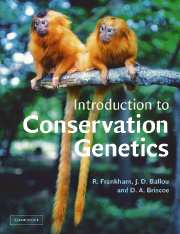Book contents
- Frontmatter
- Contents
- Preface
- Copyright acknowledgments
- Chapter 1 Introduction
- Chapter 2 Genetics and extinction
- SECTION I EVOLUTIONARY GENETICS OF NATURAL POPULATIONS
- SECTION II EFFECTS OF POPULATION SIZE REDUCTION
- SECTION III FROM THEORY TO PRACTICE
- Take home messages from this book
- Revision problems
- Glossary
- Answers to problems
- References
- Index
SECTION II - EFFECTS OF POPULATION SIZE REDUCTION
Published online by Cambridge University Press: 05 June 2012
- Frontmatter
- Contents
- Preface
- Copyright acknowledgments
- Chapter 1 Introduction
- Chapter 2 Genetics and extinction
- SECTION I EVOLUTIONARY GENETICS OF NATURAL POPULATIONS
- SECTION II EFFECTS OF POPULATION SIZE REDUCTION
- SECTION III FROM THEORY TO PRACTICE
- Take home messages from this book
- Revision problems
- Glossary
- Answers to problems
- References
- Index
Summary
Threatened species have small, or declining populations. Once small, they suffer loss of genetic diversity, inbreeding (with consequent reduction in reproductive fitness) and accumulation of deleterious mutations. All these factors increase the risk of extinction. Consequently, Section II considers these factors in detail, as they represent the major genetic issues in conservation biology, and provide the essential background material for the genetic management of threatened species in Section III.
Factors reducing population size
Humans are reducing the size and distribution of wild populations through clearing and fragmentation of habitat, over-exploitation, pollution and the impact of introduced species. Of these, habitat loss is having the greatest impact. Species are becoming extinct before they are described, and unknown numbers of invertebrate and plant species will be exterminated.
Loss of genetic diversity
Loss of genetic diversity in small populations reduces the ability to evolve in response to ever-present environmental change. There are four threats to genetic diversity:
Extinction of populations or species
Extinction of alleles due to sampling in small populations
Inbreeding reducing heterozygosity (redistributing genetic diversity among homozygous individuals and populations)
Selection reducing genetic diversity by favouring one allele at the expense of others, leading to fixation.
Overwhelmingly the major threat to genetic diversity is extinction of alleles in finite populations by genetic drift. The adverse genetic effects of population size reduction, loss of genetic diversity, inbreeding, and accumulation of deleterious mutations all depend on the effective population size, rather than the census size.
- Type
- Chapter
- Information
- Introduction to Conservation Genetics , pp. 225 - 226Publisher: Cambridge University PressPrint publication year: 2002
- 1
- Cited by



